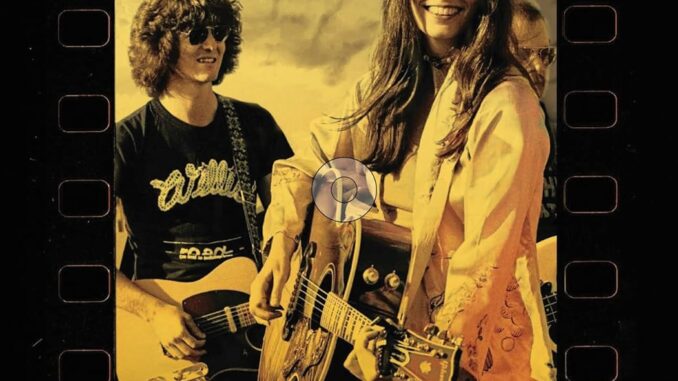
 Published in association with The Country Music Hall of Fame and Museum, this hefty (357 pages + notes) book examines what Himes calls “a musical movement of outsiders who, in time, became influential insiders.” As this includes not only Harris and Cash but figures like Guy Clark, Rodney Crowell, Gram Parsons, Ricky Skaggs, Clarence White, and Townes Van Zandt, who all show up on AUK as key elements of the more country end of Americana. In the introduction, Himes suggests that these names are an unexamined tributary of the mainstream of country music. While that may be debatable, the connection he makes between Emmylou Harris and bandmates Skaggs and Crowell and Crowell’s wife from 1979 to 1992, Roseanne Cash, and their spreading of Gram Parsons’ influence into country music is well made.
Published in association with The Country Music Hall of Fame and Museum, this hefty (357 pages + notes) book examines what Himes calls “a musical movement of outsiders who, in time, became influential insiders.” As this includes not only Harris and Cash but figures like Guy Clark, Rodney Crowell, Gram Parsons, Ricky Skaggs, Clarence White, and Townes Van Zandt, who all show up on AUK as key elements of the more country end of Americana. In the introduction, Himes suggests that these names are an unexamined tributary of the mainstream of country music. While that may be debatable, the connection he makes between Emmylou Harris and bandmates Skaggs and Crowell and Crowell’s wife from 1979 to 1992, Roseanne Cash, and their spreading of Gram Parsons’ influence into country music is well made.
His thesis starts to take shape in the second chapter, where he looks at how The Byrds drew country into rock. His big assertion here is that Roger McGuinn invented Folk Rock, Psychedelic Rock and Country Rock singlehandedly, making him the equal of Miles Davis in bringing forth musical genres. Later in the chapter, he rows back from that and, in a “credit where credit’s due” moment, allots responsibility for the introduction of country elements in the Byrds’ sound to Chris Hillman. This is something that has been suggested several times over the years here at AUK, and it’s good to see the start of Hillman getting his part in the
Another name who still appears in AUK regularly 50 years after his death and who Hillman credits as the co-creator of Country Rock with himself is Clarence White. The chapter on him, which is told through interviews with his brother Roland, himself a formidable mandolinist, but who here endorses the view of his brother’s demise as one of the great tragedies of country music.
Emmylou Harris is the thread which joins the dots of the artists featured here. Rodney Crowell and Ricky Skaggs emerge as the talents she takes special care to nurture. Having been pictured as the inheritor of Gran Parsons’ legacy many times, this book makes the case for her bands as a place where new ways of interpreting old songs and new ways of writing country songs were formed. In providing that place where talent can find its feet and experiment with mixing rock and country to produce a different music, Himes recognises in her one of the main catalysts for the next step in country music. Which, of course, is what Gram Parsons wanted to achieve.
As the book is written from a country music standpoint, you might expect it to claim these artists for country. But what this book has really done is set out the roadmap which brought us so much of the music we feature on AUK. If you take any 10 recent album reviews here, you will find the influence of the artists featured in this book. Its final service is to restore Roseanne Cash’s name to the top tier of artists. She’s not mentioned often enough in the same breath as Harris or Ronstadt as one of the great singers. If you are in any doubt about that, read Rock Bayles’ appreciation of her “King’s Record Shop” album.
You can almost picture one of Pete Frame’s Rock Family Trees spinning off from ‘In-Law Country.’ The connections between the early rock and roll and country are highlighted when Himes quotes Chris Hillman as saying, “when Elvis did those Sun sides, that was country rock. He took a Bill Monroe song and put a double-time backbeat to it… You take the backbeat out of R&B and put it into a country song, and you’ve got rock and roll.” There hasn’t been a better one-sentence explanation of the birth of rock and roll than that. Hopefully, Himes is taking that as the jumping-off point for his next book, as his insightful way with the connections between the musicians and their individual contributions is the real high point of this impeccably researched and essential book for those wanting to understand how the Country Rock and Americana we have now developed in the hearts and minds of some remarkable players.
One of the bands that gets an occasional mention in the history of country meeting rock is Nashville West. It featured Clarence White, Gene Parsons, Gib Guibeau, and Wayne Moore. Names you may know from Byrds and Burritos. This version of ‘Ode To Billy Joe‘ may not have the intensity of the vocal versions, but the guitar playing…



I’ll be getting this. Thanks Tim for the nice review
Thanks John, you’ll enjoy it!